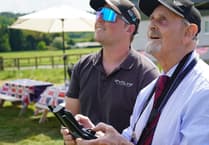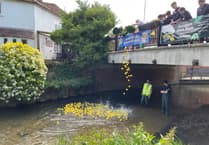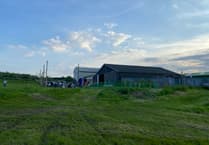You may remember last year we featured photographs of Burles House and Burles Lodge at Dippenhall (right). These houses, built by somewhat maverick Farnham architect Harold Falkner, are unique, featuring many parts collected from other buildings during his career.
Now, thanks to Susan Farrow, we are able to share with you the memories of Alan Windsor, who lived for some time in the very eccentric Burles Lodge along with a painting he made of the house during his stay.
“These recollections contradict the generally-accepted report that Falkner’s roofer Alfred Hack fell to his death off Falkner’s last project at the Black Barn in Runwick Lane,” writes Sue. “Alan was told it had happened at Burles Lodge.”
Living at Burles Lodge
(early 1960s)
We moved to Burles Lodge from London after I had started teaching at the Art School, writes Mr Windsor. We found it via the artist Leszek Muszinski, who told me to contact Harold Falkner. I found Falkner asleep in the yard at Grover’s Farm where he was doing the rebuilding. He offered us Burles Lodge to rent, which had recently been vacated by the Canadian artist Tom Luzny.
Burles Lodge was in a very dilapidated state, and had been very carelessly built. The kitchen had a Rayburn stove with an oven but the roof leaked, which I soon fixed. It was rather oddly attached to the house; we were told Falkner had forgotten the need for a kitchen until after the house had been completed. There were a few cupboards, but no conventional “kitchen furniture”.
The three principal rooms were the dining room, with beautiful gilded wall sconces with candelabra supported by eagles (which a year later Falkner simply entered while we were out, and removed); a living room with a splendid fireplace with (said to be) Grinling Gibbons carvings above, rescued by Falkner from a blitzed London church, and a large room I used as a studio, but which leaked prodigiously when it rained, and which had squirrels nesting in the ceiling, which occasionally chewed holes through the plaster. Mr Falkner ignored my requests to have the room waterproofed; the roof itself was okay, but its eaves did not overhang but were built on top of a wide concrete ledge covering the top of the wall; it was this that leaked, the walls ran with water.
The living room and this room opened on to a large terrace. Underneath this terrace and the house itself was a large space, earthen floored, with a little stream flowing through it under the house. The terrace leaked badly also, rendering it impractical as a garage, for which it was supposed to serve.
A splendid but decrepit staircase led up to three bedrooms and the bathroom on one side of a corridor. For some reason Falkner had raised the floor of this corridor with repeated flows of concrete so one stepped down into each of the upstairs rooms. From the first bedroom, a ‘French window’ door opened, unlockable, to the outside, below which was a sheer drop of perhaps 15ft; a balcony had been planned but not built. I put a bolt on it. There was no heating; we used paraffin stoves.
The bedrooms were not damp, as the roof above was very good; Falkner’s roofer Alfred Hack was excellent; unfortunately he had fallen from that roof just as he was finishing it and was killed. Tom Luzny told us the ghost of Alfred Hack could sometimes be seen at midnight, sitting on the ridge of our roof, doing his football pools as he was wont to do in life. We never saw him, though.
Outside was a round pool, designed as a swimming pool but without provision for filling, drainage or pump; it was more of a lily pool in our time. Towering over it was a stone door case from a London house, supporting a summer house above which was accessible from Mr Marchant’s garden of Burles, higher up the lane. We called this ‘the Folly’.
It was a great place to launch fireworks from on bonfire night.
Falkner had a cavalier attitude towards his tenants. He turned up in the garden now and then and dug about in a desultory manner; he finally abandoned a fork still stuck in the ground; I have it still. He also came and removed the front door case, a fine 18th-century one, one day when we were away. As a result, soon afterwards, our front door fell down in the night.
I said there was no heating in the bedrooms – but the end bedroom we used had the stove pipe from the wood-burning Rayburn passing through it, so it was warm from that. During the severe winter of 1963, when our younger daughter was a baby, we kept her cot in our bedroom where it was warm.
The panelling of the living room had been treated by Falkner with a mixture of engine oil and paraffin to make it more antique. It looked terrible. There was part of a wooden cornice running round the room – the full pattern was on one side, almost complete on another then partially done on a third side, and Falkner had tried to continue by carving a length himself, but it hardly matched and petered out unfinished after a couple of metres.
Burles House, where Mr Marchant lived with a housekeeper named Louise, had been properly built – by a team of builders, incidentally – and gave no trouble. He was a fine man – we were very friendly with him.
Harold Falkner was never very friendly towards us, although if he saw us walking up Crondall Lane when he was driving he used to swerve across the road towards us to salute – terrifying.
I did sit with him in 24 West Street sometimes while he sat among the remains of several dinners, sawing bits off valuable old chairs, but he was not very communicative. (He hated everyone to do with the art school, apart from Leszek Muszynski, who he described as “the only gentleman” on the staff).
Mr Hockey warned me against Mr Falkner when he learned we were going to rent a house from him – he said “he is a very dangerous man”. We never had trouble with him, though. We also used to see him working on his rhododendron patch near the Naydler’s house (pictured) in Dippenhall and exchange greetings. He was very proud of his rhododendrons.
He was most friendly and communicative with Tom Luzny, and they often played chess together. Tom relayed Falkner’s contempt for the art school and his dismissive opinion of John Verney. (JV and I were once at Grover’s farm when Mr Falkner had gypsies working for him. Not natural builders, they were passing building materials over from the delivery truck to their own vehicles as we watched. We thought it was like a scene from the Rude Mechanicals).
Sue continues: “There is a story about someone living in a Falkner house who complained to him there was a gap between the wall and the roof “big enough for a mouse to get through”. Falkner’s reply was: “That’s all right, you don’t need to worry until the cat can get through after it.”
“I asked Alan if the story could have been about Burles Lodge. Alan’s reply: “The story about the mouse and the cat was not about Burles Lodge, and I never heard it before. All the same, our daughter’s bedroom cupboards were accessible for the cat (Tinkle) from the roof outside.
“A huge pile of breeze blocks were left by Falkner in our garden once – we never knew what they were supposed to be for. I had to tidy and stack them. The underside of the staircase projected and I had to keep propping it up outside with tree trunks cut down from the woods as it was beginning to sag. No two windows matched, either.
“I know little about Burles, except it had been built earlier by a proper team of builders and had no problems reported to us by Mr Marchant. It had a pair of spectacularly beautiful doors separating the living room from the dining area that were said to have come from a gondola in Venice. Surely they are still there.
“There was a little cottage attached where Peter Cauchois and his wife lived (he was in the Catering Corps in Aldershot), tenants of Mr Marchant. The garden also had a supposed swimming pool, but with no provision for filling or filtering or drainage. We understood this was a regular feature of Falkner houses. He thought they all should have swimming pools but made none of the necessary provisions – I suppose pools of his generation didn’t have them. He had been a good swimmer in his time, I believe.”



